Matador Network's Blog, page 1089
May 24, 2019
Adopt Potcake dogs on Turks & Caicos

Ask a dog lover to imagine their happy place, and they just might see themselves on an island filled with playful pups.
Well, that place really exists. The island of Providenciales in Turks & Caicos is filled with rescued dogs eager for visitors to play with them — and even adopt them. Since 2005, the charity Potcake Place, located in Saltmills Plaza in the Grace Bay area, has been rescuing Potcake dogs on the island, as they often have minimal shelter and are at risk for starvation. The dogs are a mix of Labrador Retriever, German Shepherd, and English Fox Terriers, and they average about 45-50 pounds.
About 500 dogs are adopted from the island each year, and one of them could be yours for free. If you’re interested, fill out the application form on the website. (Note: You must be 25 or older.) If your application is accepted, you will choose a dog, and Potcake Place will then help you handle the details pertaining to travel arrangements.
They assure potential adopters that, “All Potcakes come with all their medical information, a record card of all their shots and information, and a vet’s health certificate.”
If adopting isn’t necessarily in your future, you can have a canine-themed island getaway nonetheless. Anyone is welcome to come to the island and play with the dogs, even if you aren’t taking one home. But people make all kinds of impulse decisions on vacation — and adopting a dog on a whim wouldn’t exactly be the worst. 
H/T: Travel & Leisure

More like this: The 7 best places in the world for dog lovers
The post Hundreds of dogs are up for adoption on this tropical island appeared first on Matador Network.
Taiwan legalizes same-sex marriage

Taiwan made history last week with the passage of a new law making same-sex marriage legal. Last Friday was first day marriage registration opened to same-sex couples. And over 500 couples immediately took advantage.
The progressive law is the first of its kind in Asia, a fact that gives many Taiwanese couples great pride. Kristin Huang, who filled out marriage paperwork on Friday with her partner, Amber Wang, said, “I feel very proud of Taiwan, because we are the first country in Asia to legalize gay marriage.”
Huang and Wang were among 20 couples who got married as a group at the district office on Friday morning, followed by a joint garden party outside.
The new law didn’t come without struggle, however. The issue proved extremely divisive, and required involvement of the Constitutional Court and a voter referendum to eventually pass. Now, same-sex couples will enjoy the same legal rights as most opposite-sex couples, including raising children together, inheriting each other’s property, and signing each other’s medical paperwork.
Beyond these practical benefits, for many couples the new law represents their long-overdue acceptance in the broader community. Yang Hsun and her new wife Hsu Pei-chieh made a point of registering in Yang’s conservative home county to make a statement. “It’s a way of giving them an education in marriage equality,” said Hsu. “We’re happy Taiwan can have this day.”
As expected, opponents of same-sex marriage have pledged to cast protest votes in the upcoming parliamentary and presidental elections. Their disaproval, however, isn’t dampening the spirits of same-sex couples, who are relishing this historic moment. 
H/T: Los Angeles Times

More like this: 15 of the best destinations for LGBTQ weddings
The post Taiwan becomes the first country in Asia to legalize same-sex marriage appeared first on Matador Network.
Slovenia hikes and nature adventures
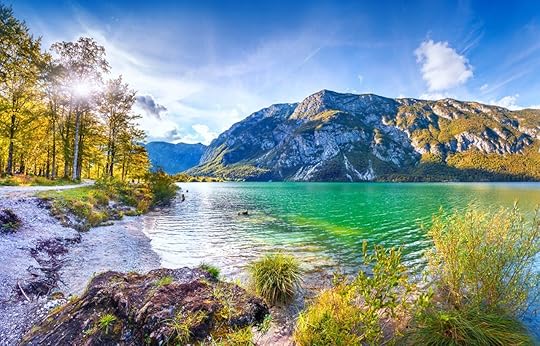
Mountains and lakes, gorges and cave systems, waterfalls and forests for days. A small country it may be, but Slovenia is big on nature. There is what feels like an endless abundance of the great outdoors to enjoy in its 7,800 square miles. Even the capital city of Ljubljana is green at heart, named European Green Capital in 2016, while more than half the country is covered in forests of beech, pine, fir, and more.
The country’s small size makes getting a taste of the varied natural beauty on offer easy to achieve in just a few weeks. You could go from the limestone heights of the Julian Alps in the north to the dense and mystical primeval forests of the south in as little as three to four hours by car. If you pass through Slovenia on your next European adventure, don’t stop only for a tour of Ljubljana and a taste of the iconic cream cake at Lake Bled. Add these five places to your itinerary and make it an epic break in nature, too.
1. Soča Valley

Photo: Netta Arobas/Shutterstock
The Soča Valley gets its name from the local river that flows through western Slovenia into neighboring Italy. The rare green color of the Soča has rightfully earned it the title “Emerald Beauty.” Photos don’t prepare you for the water’s aquamarine intensity, and heading to this corner of the country is worthwhile for the chance to swim in it alone.
A series of towns are found along the river’s course, where there are great starting points for hikes such as the Kobarid Historical Trail. The Kobarid trail combines heritage and nature, eventually leading you through a peaceful forest to the impressive Kozjak waterfall. It’s not the country’s tallest — that’s Boka, also in the Soča Valley — but it is one of the loveliest. A rush of water powers through a rugged crevice inside a cave-like hall of rock.

Photo: Michael Thaler/Shutterstock
The Tolmin Gorge is another spot to marvel at the area’s icy clear waters. It has all the beauty of the more well-known Vintgar Gorge near Bled, with far fewer crowds. Carved out by Soča’s adjoining rivers, the Tolminka and Zadlascisca rivers, the gorge has plenty of ground-level trails and wooden boardwalks that lead you around its dramatic rocky scenery. Some of the most famous formations are Bear’s Head and Dante’s Cave, credited with inspiring Hell in The Divine Comedy. Then there’s the man-made Devil’s Bridge. Towering over the gorge at nearly 200 feet, the bridge gives you a birds-eye view of the snaking river below.
2. Vršič Pass

Photo: Ales Krivec/Shutterstock
Triglav National Park’s serpentine Vršič Pass is the highest mountain pass in Slovenia and is notorious for its 50 hairpin turns. Despite the very well-maintained roads, it’s inevitably a bit of a hair-raising drive. Brave the twisting inclines, though, and you’re rewarded with awe-inspiring vistas of the Julian Alps at every turn.
There are plenty of stop-off points where you can pull in and admire the almighty Mount Triglav, the tallest mountain in Slovenia at 9,396 feet, and the surrounding peaks. Also keep an eye out for the Prisank Window, a natural mountain opening that measures almost 250 feet high and around 130 feet wide. Also on Mount Prisank, which is sometimes called Prisojnik, is the myth-laden Buckwheat Girl. “She” is a surprisingly well-formed face that has naturally appeared in the jagged mix of white and gray limestone, though folklore suggests it’s actually a nymph who was turned to stone.
3. Lake Bohinj
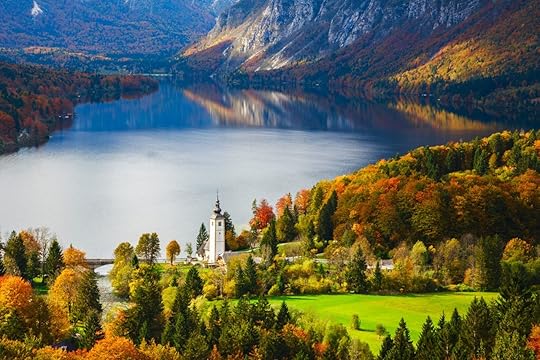
Photo: Fesus Robert/Shutterstock
While Lake Bled, Slovenia’s most popular lake, is lovely, we recommend heading to Lake Bohinj, where you’ll find a more peaceful, remote, and beautiful setting — in a rugged, natural way. Lake Bohinj’s water is a deep blue-green shade, reflecting the surrounding mountains that are blanketed in coniferous forest. A ride in the cable car up to Mount Vogel gives you a completely eye-opening aerial perspective on just how vast this glacial lake really is.
Aside from admiring its impressive size and picturesque looks, one of the best parts of visiting Lake Bohinj is that there are so many ways to spend time in nature. You can easily fill three or four days hanging out on its banks, swimming, hiking, cycling, kayaking, stand-up paddleboarding, or canoeing. If you’re an adventure seeker and seriously short on time, we’d skip Bled altogether and make the most of Bohinj. Controversial, maybe, but honestly worth considering.
4. Kočevje aka the Bear Forest

Photo: Neil Burton/Shutterstock
Way down in the south of Slovenia is the Kočevje region, an area of unspoiled, pristinely wild forests of mostly beech and fir. These enchanting woodlands are UNESCO protected, and it’s easy to understand why. Human interference has been seriously limited — there are even some entirely virgin forests where entry is strictly prohibited — and the area is far from the country’s well-trodden tourist routes. Thanks to this, it feels secluded and tranquil on the hiking trails, and you’re unlikely to see other people during your walks.
The residents of Kočevje’s forests attract a good deal of attention: The area has one of the highest populations of brown bears in Slovenia and the rest of Europe. The bears are famously elusive and shy, so you’re still unlikely to bump into one. If you do want to try a spot of bear watching, connect with a local guide who can ensure it’s done safely on the proper trails — and with minimal disturbance to the animals.
While you’re in Kočevje, check out the majestic Queen of Rog near the Rajhenav virgin forest. It’s one of the country’s tallest fir trees, causing you to strain your neck as you attempt to take in all 170 feet. Four grown men struggle to get their arms around the trunk, which explains the tree’s less complimentary nickname of Debela Jelka, or “the Fat Fir.”
5. Škocjan Caves

Photo: Andywand/Shutterstock
Slovenia is just as interesting for nature lovers on a subterranean level as it is overground. A series of spectacular karst cave systems lie underfoot, including the Škocjan Caves. Like the forests of Kočevje, they have UNESCO accreditation, labeled as a World Heritage site.
Erosion and corrosion of limestone rock caused by the Reka River are responsible for the nearly four-mile series of caves, dotted throughout with stalagmites and stalactites that have been growing steadily over thousands, even millions, of years. Lots of the rock is white in color and glitters brightly, even under the dim lighting. Today, the river rushes through a huge underground canyon, producing an immense sound that backdrops guided walks around the open-to-public areas.
The highlight of a tour around the Škocjan Caves is entering the largest discovered underground cavern in Europe, Martel’s Chamber. It’s otherworldly, like a set straight out of Lord of the Rings, except this is real and formed entirely by nature. Your tolerance for heights determines how quickly you cross the Cerkvenik Bridge, which hangs over one of the highest points in the cavern. Look out for the original pathways laid down by the early explorers of the caves, too. They make you glad to be standing on the safe and stable tourist paths of today. 

More like this: Here’s why Montenegro is an outdoors paradise
The post 5 places to see Slovenia’s incredible natural beauty appeared first on Matador Network.
Traditional dishes from Oaxaca
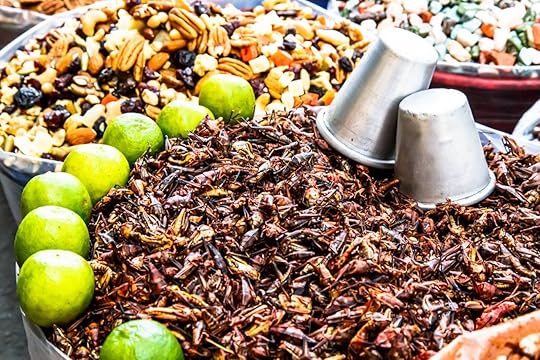
Mexico’s diverse culinary landscape has traces of the many cultural groups that have shaped the region’s history. There’s pan dulce, or sweet bread, which is based on the bread 17th-century French bakers brought to Mexico, and the quintessential tacos al pastor inspired by the shawarma that Lebanese immigrants introduced at the turn of the 20th century. Then there are the crops, animals, and cooking techniques introduced by the Spanish.
While today’s Mexican food is a hybrid, it still abounds with dishes, ingredients, and techniques that predate European colonization. The state of Oaxaca is one of the best places to see this cuisine. Oaxaca has Mexico’s largest indigenous population, and the traditions maintained by its 16 indigenous groups represent a cultural heritage that spans thousands of years. In addition, the state’s varied microclimates allow it to produce a wealth of native plants and herbs that contribute to the diversity of its cuisine.
Stroll down Oaxaca’s streets or into its kitchens and you’ll find elements of the state’s indigenous heritage in everything from the use of ancient cooking techniques to traditional ingredients. Whether you’re eating from a market stall or at an upscale restaurant, chefs will use a molinillo (wooden whisk) to create foam over hot chocolate and a molcajete (stone mortar and pestle) to grind salsas and pastes. Tortillas are cooked over the comal (flat griddle), often over a traditional wood oven that’s fanned by woven palm fronds. Pre-Columbian staples like chiles, tomatoes, corn, beans, and squash continue to form the backbone of the cuisine, and many of the state’s most famous foods, like mole and chapulines (grasshoppers), have been prepared since pre-colonial days.
These are the 11 foods with pre-Hispanic origins not to miss in Oaxaca.
1. Atole

Photo: Lemonpink Images/Shutterstock
It’s hard to overstate the role that corn has played in Mexico’s history. It’s said that sin maiz no hay pais — “without corn, there’s no country.” Mexico’s indigenous people were the first to domesticate the plant, turning it from a wild, inedible weed into the staple food of an empire. The earliest known maize domestication was in the Guilá Naquitz Cave in Oaxaca.
In Mexico, corn is consumed in everything from tortillas to pozole soup. It’s also the basis for many drinks, and atole is a wonderful way to enjoy it in liquid form. The hot, frothy drink has a porridge-like texture and is sweetened with cinnamon and piloncillo (unrefined cane sugar). It’s a soothing way to warm up on a cool morning, best accompanied by a piece of pan dulce or a tamale. You can try its cousin, champurrado, which is prepared similarly but adds chocolate.
2. Tejate
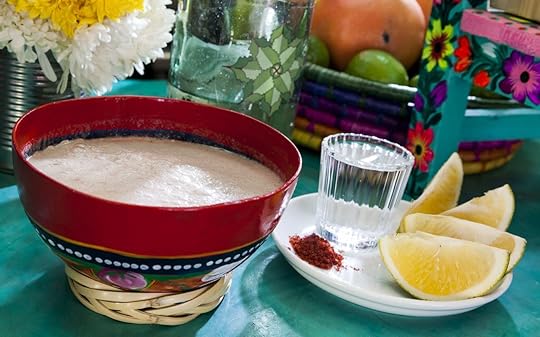
Photo: Photosphere/Shutterstock
Another corn-based beverage not to miss is tejate, a drink that’s native to the village San Andrés Huayapam, just outside of Oaxaca City. Made from toasted corn, fermented cacao, mamey pits, and cacao flower, the non-alcoholic drink is known as the beverage of the gods due to its role in Mixtec and Zapotec rituals. After the ingredients are ground and mixed by hand, the result is a refreshing drink with a subtle cacao flavor and a frothy foam on top. You can find it at market stalls, in Oaxaca City’s Zocalo public square, and along the touristy walkway that runs through the city center.
3. Nicuatole

Photo: Aurora Angeles/Shutterstock
Nicuatole is a popular Zapotec dessert. The name comes from a combination of the Nahuatl words necuatl or necutli, meaning syrup, and atole. The slightly sweet gelatin has a corn base and a flan-like texture. While it’s commonly sweetened with sugar, its pre-Columbian iteration used maguey syrup as a sweetener. It’s commonly sold as a snack at markets or on the street and can be flavored with pineapple, coconut, mango, nuts.
4. Tamales

Photo: FERNANDO MACIAS ROMO/Shutterstock
One of Mexico’s most iconic foods is the tamale. The name comes from the Nahuatl word tamalli, meaning “wrapped.” During the pre-Hispanic era, tamale-making was highly ritualized with different ingredients corresponding to different seasons of the year. On the Oaxacan coast, tamales were made with shrimp, pumpkin seeds, and hierba santa, a common herb. The arrival of the Spaniards brought additional fillings like pork and cheese. You’ll find many varieties of tamales in Oaxaca. The most popular ones are filled with beans, avocado leaves, jalapeños, cheese, and different flavors of mole. And then there are the exquisite tamales Oaxaqueños, or Oaxacan tamales, which are wrapped in banana leaves and filled with chicken, turkey or pork, and mole negro.
5. Chocolate
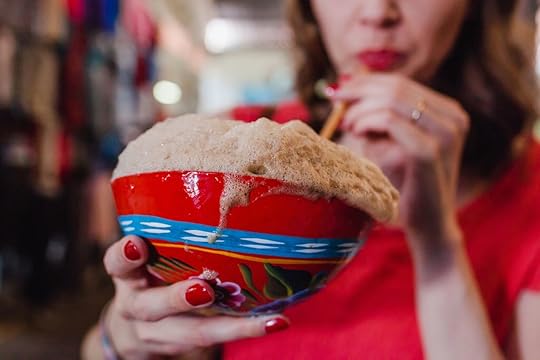
Photo: Marcos Castillo/Shutterstock
A staple breakfast in Oaxaca is chocolate (pronounced chocolate-ay), which is essentially hot chocolate. It’s made from a blend of ground cacao, sugar, almonds, and vanilla, and prepared with either milk or water. The Olmecs were the first cacao producers, and before the conquest, cacao-based drinks were prepared throughout the Americas using a blend of cacao with vanilla and chile. The most traditional way to consume chocolate is with water as milk and sugar were additions from the Spaniards. Be sure to eat it with sweet bread, such as pan de yema (egg yolk bread).
6. Sopa de piedra
Hailing from the Chinantec region in northern Oaxaca, sopa de piedra, literally “stone soup,” comes from the indigenous community of San Felipe Usila. The recipe has been passed down from generation to generation, and oral histories point to the soup as an important culinary innovation for the community. Piping hot stones serve as the cooking agent. They are heated until they turn bright red and then dropped into a broth containing fish or shrimp, chile, tomato, onion, and cilantro. The dish is rarely found on menus in Oaxaca City, but you can find it at Caldo de Piedra, which has eateries in Centro and the town of Tlalixtac de Cabrera.
7. Chapulines
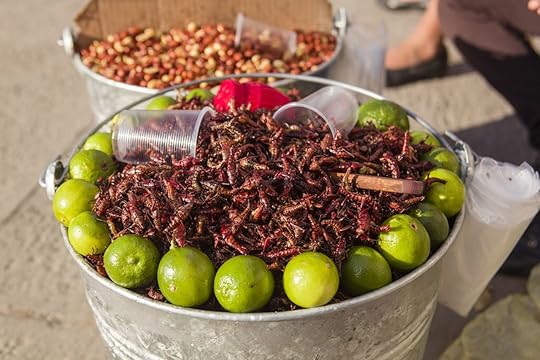
Photo: erlucho/Shutterstock
Chapulines, or grasshoppers, are an emblematic part of Oaxaca’s cuisine and have been eaten in the region for centuries. Prior to the arrival of the Spaniards, Oaxaca’s indigenous people didn’t tend pastoral animals like cows or sheep. Instead, they got their protein from the guajolote (wild turkey) and by consuming insects like grasshoppers. Crunchy and flavorful, chapulines are toasted and seasoned with chili and lime. They can be eaten solo or sprinkled over tacos or tlayudas — fried tortillas topped with beans, meat, and lettuce — and are frequently ground into a spicy salsa. To get a taste, head to the 20 de Noviembre market. Look for women who carry large baskets of them, or they’ll find you as you wander the stalls.
8. Chicatanas
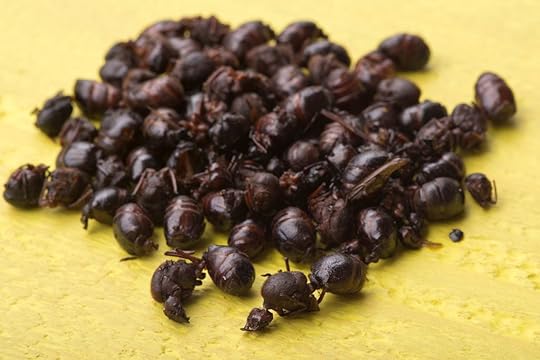
Photo: Chad Zuber/Shutterstock
Grasshoppers aren’t the only native insect to be consumed in Oaxaca. Another seasonal delicacy is a variety of flying ants called chicatanas. After the first rains of the year, the ants come out in droves and are harvested during a period that lasts just one to 10 days. They’re then toasted on the comal with salt, lime, and garlic. Like chapulines, they can be eaten as a snack or ground into a salsa. Either way, they are considered a delicacy that can run $20/kilo.
9. Iguana eggs
While Oaxaca is a small state geographically, part of its gastronomical wealth comes from its many microclimates. In the tropical Isthmus of Tehuantepec, the region that connects Oaxaca to neighboring Chiapas, the Zapotec people have long enjoyed both iguanas and their eggs. The iguana meat is stewed with a mix of tomatoes, onions, garlic, and achiote. And during Holy Week in Juchitan, the largest city in the region, it is typical to see iguana egg tamales sold in the markets.
10. Nopales

Photo: Marc Sitkin/Shutterstock
Nopales (prickly pear cacti) are a common pre-Hispanic food that can be enjoyed in many Oaxaca dishes. The paddles are picked while tender and may be sauteed and served with eggs (huevos con nopal), in salads, or in soups. Meanwhile, the tuna, or prickly pear fruit, has several culinary uses. You can eat the fruits whole while they’re green (they’re seedy but delicious) or enjoy them as a flavoring for nieves (ice cream) or horchata (a sweet rice milk drink).
11. Mole

Photo: jvmodel.com/Shutterstock
Oaxaca is often nicknamed “the land of seven moles,” and the diverse forms of this dish are a testament to the complexity of the state’s cuisine. Each variant of the sauce derives its flavor from a different chile combination, and many contain upwards of 20 ingredients — typically a laundry list of nuts, seeds, and chiles; toasted onion, garlic, and tomatoes; a piece of bread or tortilla; and perhaps some chocolate. Its preparation is notoriously lengthy and laborious, but once the flavors meld together, the result is unmistakably complex — rich, spicy, and a little sweet.
The word mole comes from the Nahuatl mulli, meaning mixture. The Spaniards documented a number of different moles, from a ceremonial dish served to the emperor Moctezuma to others prepared with ingredients still used today like chiles, tomatoes, and pumpkin seeds. While most Oaxacans consume mole as a staple dish at celebrations, you can find it on menus throughout the city, most often served with turkey over rice or stuffed into a tamale. 

More like this: 7 traditional dishes from the Yucatán Peninsula better than tacos and burritos
The post 11 pre-Hispanic dishes that show Oaxaca is the cradle of Mexican food appeared first on Matador Network.
Three more Everest deaths this year

Everest has always been a perilous peak, but this climbing season has proven particularly fatal. While descending the mountain on Thursday, three climbers died of exhaustion, making a total of seven who have died on Everest just this week — more than the total number of deaths on the mountain all last year. The three most recent deaths were Kalpana Das and Nihal Bagwan of India and an unnamed Austrian climber. Many are blaming high traffic near Everest’s summit, causing delays in descent and dangerous conditions for climbers.
Nepal has issued 381 permits for the spring climbing season, which may not sound like a lot, but when time is of the essence at high altitude, any delay can prove deadly. According to local tour organizer Keshav Paudel, Bagwan had been “stuck in traffic for more than 12 hours and was exhausted.” Many have called for limiting the number of permits issued each year to reduce congestion at the summit. Ben Fogle, adventure and television presenter, suggested a “London Marathon-style lottery” for climbing permits.
Conditions on the mountain have also been worse than usual this year, with high winds leaving climbers with little time to reach the summit safely.
Just yesterday, an American perished on Everest due to similar reasons. He was caught in the bottleneck of Hillary Step, passed out, and couldn’t be revived. Right now, the death toll this climbing season stands at an alarming 16. 
H/T: BBC

More like this: 10 things I wish I knew before trekking Mount Everest Base Camp
The post Three more climbers die on Everest, bringing the total to seven this week appeared first on Matador Network.
The best South Korean food
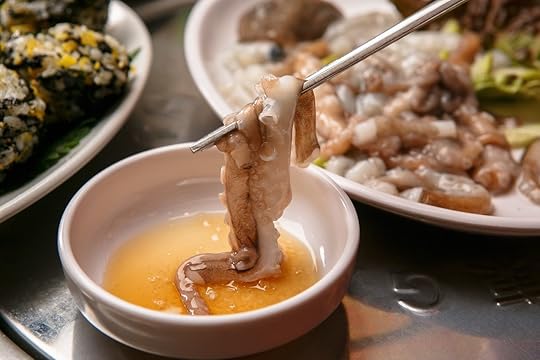
Korean food is growing in popularity in the West. Kimchi is being integrated into burgers, fries, nachos, and more. Korean barbecue is far from a foreign concept. But those foods are just the tip of the iceberg.
South Korea’s coast has countless fishing villages and fish markets brimming with sea urchins, conchs, abalone, octopods, and gaebul (a type of marine worm). Seafood and seafood products like fish sauce are incorporated into many Korean dishes, including soups, stir fry, fish cakes, and kimchi. Seaweed (kim or gim) is eaten almost daily in various forms. This sea-inspired cuisine tends to be on the salty side, and almost always has a spicy kick. If shellfish and crustacea are not your thing, don’t despair. Beef and pork are readily available.
Needless to say, there’s a lot of different foods to try. These are the need-to-know foods that will have you wondering about why you haven’t done a food tour through Korea yet.
1. Kimchi

Photo: naito29/Shutterstock
Kimchi has long been a staple in Korean cuisine. Case in point: there’s an entire museum dedicated to it in Seoul. Kimchi is fermented cabbage that’s been rubbed with fish sauce, pepper paste (gochujang), and other spices. It was traditionally made by putting the mixture into clay pots and buried in the ground, but it’s also industrially produced now. Kimchi is sour and spicy, and is eaten for breakfast, lunch, and dinner. While cabbage is the typical main ingredient, it’s common to see variations made with cucumber or daikon radish.
2. Barbecue
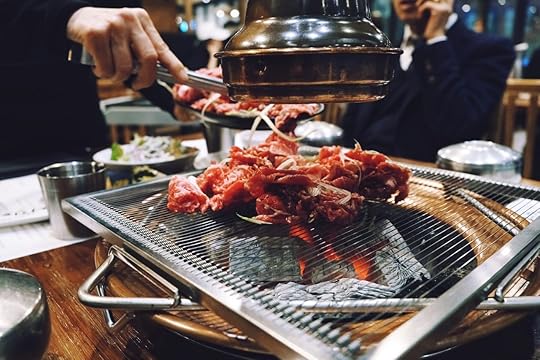
Photo: Evgeniya Anfimova/Shutterstock
As with kimchi, Korean barbecue comes in many forms. The most common and popular choices are galbi (marinated short ribs) and samgyupsal (pork belly). Barbecue is a communal event, so everything on the table is up for grabs. Orders are made per serving of meat, which is brought to your table raw with onions, mushrooms, and garlic. The meat is cooked on a charcoal grill in the middle of your table and cut into bite-sized pieces. Then, you take a leaf of lettuce and load it up with a little bit of whatever you want.
3. Banchan
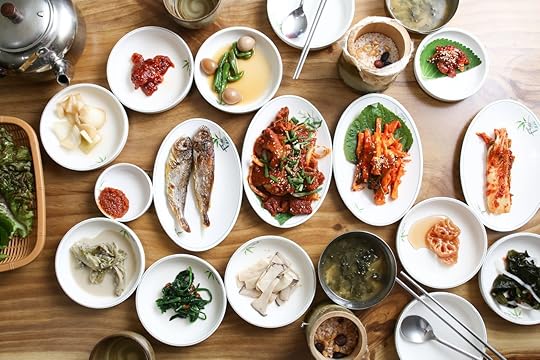
Photo: KYTan/Shutterstock
Banchan are side dishes that come with your meal. Depending on the size of the meal, it may just be rice and kimchi. But if you order barbecue or another large meal, banchan could include fish cakes, sauteed spinach, daikon radish, japchae (sweet and savory glass noodles), bean sprouts, fried fish, zucchini, tofu, gochujang, seaweed, and so much more. These sides vary day to day as well as place to place, so it’s always a little surprise.
4. Bibimbap
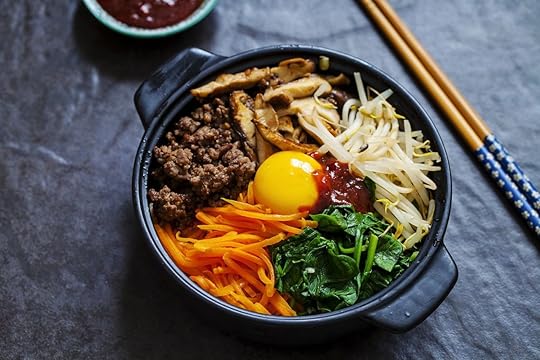
Photo: Magdanatka/Shutterstock
Bap is the Korean word for rice. Rice is served alongside every meal, but a few menu items in particular stand out. One is bibimbap, which is basically a rice bowl, served hot or cold, with a topping of zucchini, carrots, fernbrake, bean sprouts, and often a raw or fried egg. Many add in meat, as well as gochujang, to their liking.
5. Kimbap
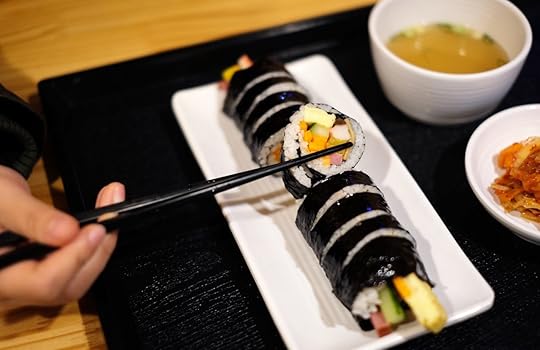
Photo: Alland Dharmawan/Shutterstock
Think of kimbap as a type of Korean sushi minus the raw fish. It’s made in the same fashion with rice and kim, and rolled with ingredients such as ham or crab, egg, carrots, pickled radish, and cucumber. It’s basically the equivalent of a sandwich in that it’s a light lunch or snack that’s easy to take with you.
6. Mandu

Photo: Brent Hofacker/Shutterstock
Mandu are similar to potstickers. These steamed or fried dumplings are filled with vegetables, meat, or kimchi. You can order them as part of your meal, put them in soup, or get the big puffy version from a roadside stand. Either way, your stomach will thank you.
7. Dakkochi
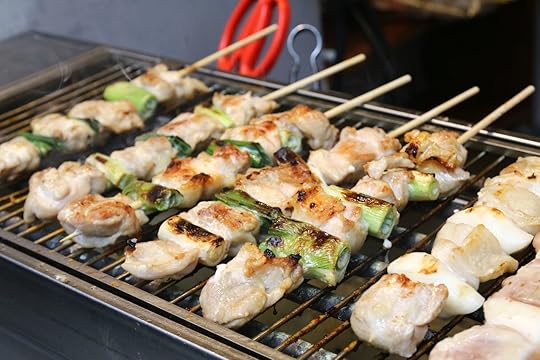
Photo: KYTan/Shutterstock
Street food in Korea is extremely popular. School kids gather around food carts in between classes, businessmen duck into pop-up street “restaurants” after work, and people fill up on cheap bites before heading out for a night of dancing. Dakkochi, or chicken on a stick, is one of the most common. It’s coated in a gochujang sauce that’s sweet, savory, and spicy.
8. Tempura
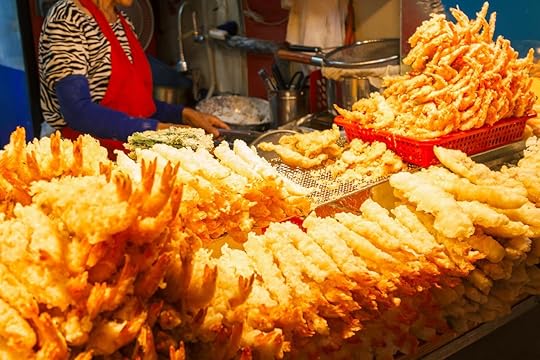
Photo: Sanga Park/Shutterstock
Tempura is a common street food, and it includes everything fried. Nothing says Korean street food like deep-fried squid tentacle. If that doesn’t appeal to you, there are other options to fry, such as sweet potato, onion, vegetable fritters, shrimp, and boiled eggs. Each costs about 500 Korean won, or 50 cents, from a food cart.
9. Tteokbokki
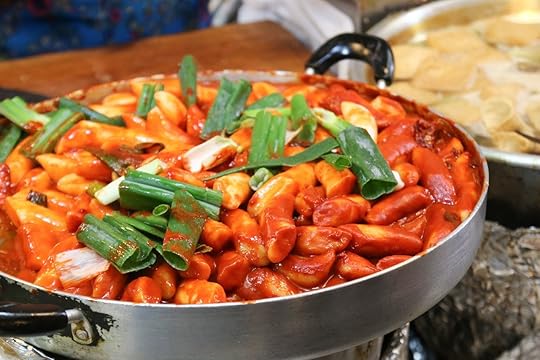
Photo: KYTan/Shutterstock
Tteokbokki is a spicy mix of rice cakes and gochujang that’s a common street food snack. It’s often served with a soy-based broth and odeng, a kind of savory fish cake.
10. Sannakji

Photo: TMON/Shutterstock
You may be put off by the thought of eating a live octopus, or sannakji. It’s a controversial dish, but it is a classic. Sannakji is a hoe, or raw dish, of small octopus tentacles that are served still wriggling. It’s eaten by itself or with some red chili paste.
11. Beondegi
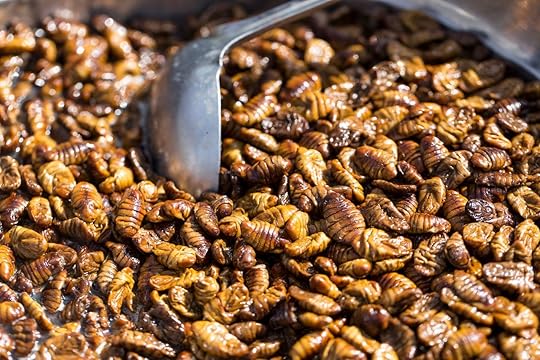
Photo: mujijoa79/Shutterstock
Beondegi is steamed silkworm pupae with a pungent fishy smell that’s typically served boiled or steamed from roadside carts. The popular snack is often spiced, and there’s a candied version as well. The taste is similar to the smell: nutty and fishy.
12. Soju
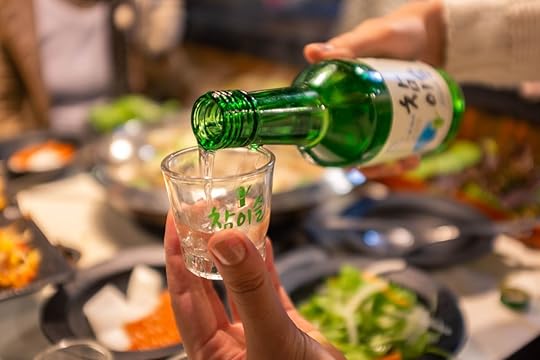
Photo: me Darat/Shutterstock
You can’t talk about Korean food without mentioning soju. It’s one of the most popular spirits in the world. It’s traditionally made from rice, wheat, or barley, but there are brands making it from sweet potatoes and tapioca as well. Soju ranges from around 17 percent ABV to more than 50 percent ABV, and one of the most common versions comes in a little green bottle. As with food, soju is a communal drink. If someone else at your table takes a sip, you do too. When their glass is empty, it’s proper etiquette to refill it for them. Because of its mild flavor, it mixes well with almost anything — including beer. When mixed with beer (maekju), it’s called somaek. 

More like this: 8 sweet, chewy, and colorful Korean desserts you’re missing out on
The post 12 essential Korean foods, from savory street snacks to live octopus appeared first on Matador Network.
Top counterculture spots in Berlin

There’s a saying that makes much more sense to Berliners than to those who haven’t been to the German capital. “Paris is always Paris and Berlin is never Berlin.” Each time you come, there’s a piece of history, a unique work of art, or perhaps a long-abandoned building that you didn’t know existed but has now been converted into a counterculture hub. While most tourists in Berlin go on the typical tour covering the Berlin Wall, Checkpoint Charlie, and Brandenburg Gate, there is so much more waiting to be explored. If you’re looking for an alternative experience of Berlin stemming from the famous counterculture, these are the top things you need to check out.
Step into the city’s squatter past on a free alternative walking tour.

Photo: Ewa Studio/Shutterstock
To dive right into an “alternative” Berlin experience, start with a free walking tour from Alternative Berlin. This jaunt through time will take you through the old artist neighborhoods in Friedrichshain and Kreuzberg as your host explains the history and political background of the places. Both East and West Berlin saw an active punk and rebel scene during the days of the wall, with young residents expressing themselves in any way they could. Expect to see the remnants of this time, along with plenty of street art, graffiti, and murals on this tour. For those of you that would love to see the artistic side of Berlin, the tour also includes urban farms, art projects, and unique shops. You can join the walking tour directly at 11:00 AM and 1:00 PM from the Alexanderplatz TV Tower. It’s free, though tips are appreciated, and lasts for about three hours.
Check out the YAAM beach club.
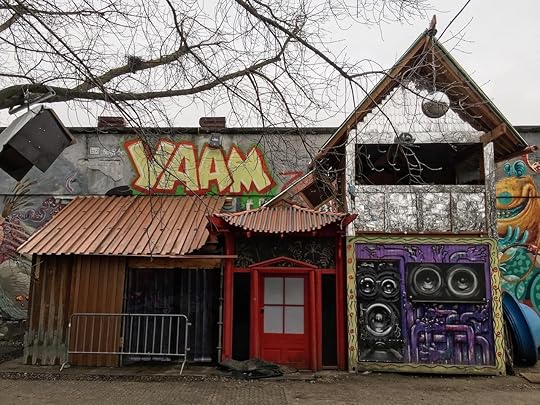
Photo: YAAM Berlin/Facebook
Berlin’s counterculture scene lives on throughout the city these days, but perhaps nowhere more so than at the Young African Art Market, referred to as the YAAM. Here you’ll experience a club, a beach bar, and an art gallery all within a space that hosts music and art events throughout the year. It’s situated directly at the river beach in the heart of the city. If you visit Berlin in summer, be sure to check out this thriving beach club where you can chill and hang out with the locals. If you’re not in the mood for a reggae concert, the standard show here on many nights, you can also just grab a beer and enjoy the sunset at the beach as many locals do.
Admire artists at the Urban Spree Gallery.

Photo: Urban Spree/Facebook
Beyond the YAAM, the Urban Spree Gallery is Berlin’s massive hub of urban art exhibitions, DIY workshops, and concerts. Set in a 70,000-square-meter industrial compound, the facility invites artists for on-premise residency programs and is also home to an on-site art store and beer garden. The gallery also has monthly art shows with a huge “artist wall” that has showcased the likes of Klone, Zevs, Twoone, Nychos, The Grifters, and more in its time, and if you’re in town while a show is happening, your odds of rubbing shoulders with big-time players in the underground Euro art community are high. In the summer, the beer garden is an excellent place to meet Berliners and enjoy local draft beers. In a tip of the hat to its counterculture roots, the gallery also showcases street musicians from across town each summer weekend.
Explore subterranean Berlin to see the underground tunnels.

Photo: Berliner Unterwelten e.V./Facebook
Among the reasons for Berlin’s reign as a counterculture hub is that citizen uprisings and anti-authoritarian action have played such a large part in the city’s history. The subterranean Berlin museum, called Berliner Unterwelten, is the perfect way to celebrate them. Here you can check out the tunnels that were used to smuggle people outside Germany during World War II and while the city was divided in two. You’ll be transported to underground bunkers half-blasted with cables and broken stairways with rubble still on the floor. You’ll experience how it must have felt to seek shelter in the bunkers during the war and escape from East to West Berlin.
Situated four floors below Berlin, this underground experience will take you through old canals, tunnels, storage rooms, air-raid shelters, and deserted subway stations. You can also see an exhibition of Hitler’s “Germania” — his utopian vision of rebuilding Berlin. This is likely to be the most memorable experience you’ll have on a trip here. But, tour tickets must be purchased in advance and in person, so make sure to get them before you plan to visit.
Groove to techno music in an abandoned power plant at Tresor.

Photo: Tresor.Berlin (OFFICIAL)/Facebook
Move over Berghain, the trendy mainstream club where even after waiting in line the whole night, you still may be refused at the door. Head to Tresor instead for a truly humbling techno experience and a dose of history while you’re at it. Tresor is the largest and most respected techno club in Germany, dating back to the original dance scene here when clubs were first opened in unified Germany. Located in an abandoned power plant with seven floors of different music, there is something happening for every techno lover on any given night. It’s a great place to meet other international tourists who are in town for similar reasons and enjoy the experience that this legendary club offers. You might just be watching a rising star in addition to the headliners, as some of Berlin’s most popular DJs have started out with Tresor Records, the club’s in-house label. 

More like this: How currywurst became Berlin’s favorite street food (and where to try it)
The post How to experience Berlin’s famous counterculture appeared first on Matador Network.
Hedonism swingers resort in Negril

Body painting is like the ambiguous gray area between being clothed and naked. Technically, you’re not wearing any clothes, so your body is completely exposed to everyone around you. On the other hand, as Sport Illustrated showed us a few years ago, good body paint looks like clothes — though try explaining that to the police when you decide to go grocery shopping in body paint.
One place where the semantics of body paint never matter, though, is at Hedonism II. The world’s premier clothing-optional, “adult lifestyle” resort in Negril, Jamaica, has no problem with how you choose to cover your body, if at all. And this summer, it’s inviting guests to explore the world of body painting like never before at the first-ever “Bodypalooza.”
From August 13-18, guests will have a chance to be painted by some of the greatest body paint artists in the world, such as folks who’ve appeared on Body Wars and America’s Got Talent like Nick Herrera, Kaos, Vantasy, and John Neyrot, if those names mean anything to you.
For a fee they’ll dress you up in whatever painted-on creation you — or they — can imagine, which will vary by artist and complexity of design. The artists will also be competing to see who can create the best human paint jobs, so you’ll be able to marvel at some “outfits” that look like they just stepped off the runway.

Photo: Hedonism II
As with every week at Hedonism, there’ll also be theme nights. But this time around you’ll be painting your costumes instead of wearing them. Themes will include superheroes versus villains; fantasy carnival; fetish; and ‘70s/‘80s rock star. Though if you’re trying to look like Tommy Lee, there’s probably not enough paint in the world for that.
Guests will be able to paint each other, if they’re so inclined, competing in their own nightly contest to see who the best amateur artist is. Playmates and models will also be on hand as human canvases, though definitely check and make sure your partner is okay with that before you start painting them.
Can’t paint your laundry room, much less your partner’s backside? No sweat, as the artists in residence will be offering all varieties of workshops and seminars throughout Bodypalooza, including advising couples on how to do body impressions. This will be a must-do if you’ve ever wanted to have one of those “guess how we made that” pieces hanging in your house.
“Palooza means ‘drunken gathering of friends with the goal of partying,’” said Michelle Facey, Hedonism II’s social engagement manager, and the person who dreamed this whole thing up. “I added the ‘body’ part. That seems to fit what we do here.”
If this all sounds enticing to you, it’s open for booking as we speak. And if you want to go, but can’t afford to throw down a couple grand to get paint all over your body, Hedonism is also running a simple contest on social media. Just tag two friends and you’ll be entered in a drawing to win a few days for free.
So warm up your painting fingers and get ready for the craziest sort-of-naked week of your life. Just make sure to shower well before you put on any of your civilian clothes. 

More like this: 10 nude beaches in the most unexpected places
The post Hedonism is throwing a weeklong party where everyone only wears body paint appeared first on Matador Network.
Worst times to travel Memorial Day

Memorial Day is approaching, and many Americans are getting ready to take their first vacation of the summer. This year is poised to see a spike in Memorial Day travel, with 1.5 million more people hitting the road for the holiday than last year, according to AAA’s tracking data. In all, there will be about 37.6 million road travelers. Highways are bound to be congested, but these delays are avoidable if you know exactly when to travel. Enter INRIX, a traffic analytics company that has created a list of the worst days and times to travel this weekend.

Photo: AAA
“Drivers in the most congested metros should expect much worse times than normal,” Trevor Reed, transportation analyst at INRIX, told AAA. “Travelers should anticipate delays to start on Wednesday and continue through Memorial Day. Our advice to drivers is to avoid the morning and evening commuting times or plan alternate routes.”
If you’re still figuring out where to go for Memorial Day and want to avoid any traffic, it may also be a good idea to avoid this year’s top-booked destinations. According to advance AAA travel bookings, the top five cities this year are Orlando, New York, Las Vegas, Honolulu, and Anaheim. 

More like this: The cheapest times to book travel for every major holiday for the rest of the year
The post Data reveals the worst days and times to travel on Memorial Day weekend appeared first on Matador Network.
Grandmother jailed for carrying CBD

Lena Bartula, 71, was en route to visit her granddaughter in Oregon when she was arrested at Dallas-Fort Worth International Airport after police officers found CBD oil in her travel bag. Bartula told NBC that she was then driven to the airport jail, where she “slept on the floor, my head next to the toilet.”
The next day, her arms and legs were shackled and she was moved to Tarrant County Jail in Fort Worth for another night before being slapped with a felony drug charge. Hemp-made CBD was legalized in December with the federal farm bill, but customs officials argue that the law is still in the process of being implemented, so for now, products with THC are still illegal at ports of entry.
Bartula, however, was totally unaware of this restriction. Originally from Fort Worth, Bartula now lives in Mexico and works as an artist, running a popular art gallery. She uses CBD oil because it gives her relief from her aches and pains.
Luckily, her case was dropped after a grand jury hearing, but this is probably the last time she’ll be traveling with CBD oil. 
H/T: NBC

More like this: Can you take CBD on a plane? It’s complicated.
The post 71-year-old grandmother jailed for CBD oil at Dallas-Fort Worth Airport appeared first on Matador Network.
Matador Network's Blog
- Matador Network's profile
- 6 followers



